Aeromagnetic Data Analysis for Sustainable Structural Mapping of the Missiakat Al Jukh Area in the Central Eastern Desert: Enhancing Resource Exploration with Minimal Environmental Impact
Abstract
:1. Introduction
2. Materials and Methods
2.1. Reduction to the North Magnetic Pole (RTP)
2.2. Spectral Frequency Analysis
2.3. Upward Continuation
2.4. Euler Deconvolution
2.5. SPI Technique
2.6. GPSO Technique
3. Results and Discussion
3.1. Aeromagnetic Maps (Observed, Regional, and Residual)
3.2. Subsurface Structure Estimation
3.3. Structural Lineament Maps
4. Conclusions
Author Contributions
Funding
Informed Consent Statement
Data Availability Statement
Acknowledgments
Conflicts of Interest
References
- Hamimi, Z.; Abd El-Wahed, M.; Gahlan, H.; Kamh, S. Tectonics of the Eastern Desert of Egypt: Key to understanding the neoproterozoic evolution of the Arabian–Nubian Shield (East African Orogen). In The Geology of the Arab World—An Overview; Springer: Berlin/Heidelberg, Germany, 2019; pp. 1–81. [Google Scholar]
- Hamimi, Z.; Abd El-Wahed, M.A. Suture (s) and major shear zones in the Neoproterozoic basement of Egypt. In The Geology of Egypt; Springer: Berlin/Heidelberg, Germany, 2020; pp. 153–189. [Google Scholar]
- EGSMA. Geologic Map of Al-Qusayr Quadrangle; EGSMA: Cairo, Egypt, 1992. [Google Scholar]
- Nabawy, B.S.; Barakat, M.K. Formation evaluation using conventional and special core analyses: Belayim Formation as a case study, Gulf of Suez, Egypt. Arab. J. Geosci. 2017, 10, 1–23. [Google Scholar] [CrossRef]
- El-Gendy, N.; Barakat, M.; Abdallah, H. Reservoir assessment of the Nubian sandstone reservoir in South Central Gulf of Suez, Egypt. J. Afr. Earth Sci. 2017, 129, 596–609. [Google Scholar] [CrossRef]
- Abdelwahab, F.; El Gendy, N.; Barakat, M.K.; Mohamed, M.; El-Tohamy, A.; El Terb, R.; El Feky, M. Radionuclide Content and Radiation Dose Rates of Uraniferous and Mineralized Granites at GV Occurrence in Gabal Gattar, Northeastern Desert, Egypt. J. Phys. Conf. Ser. 2022, 2305, 012006. [Google Scholar] [CrossRef]
- Azab, A.; Nabawy, B.S.; Mogren, S.; Saqr, K.; Ibrahim, E.; Qadri, S.T.; Barakat, M.K. Structural Assessment and Petrophysical Evaluation of the pre-Cenomanian Nubian Sandstone in the October Oil Field, Central Gulf of Suez, Egypt. J. Afr. Earth Sci. 2024, 218, 105351. [Google Scholar] [CrossRef]
- Reford, M.; Sumner, J. Aeromagnetics. Geophysics 1964, 29, 482–516. [Google Scholar] [CrossRef]
- Oruç, B.; Selim, H. Interpretation of magnetic data in the Sinop area of Mid Black Sea, Turkey, using tilt derivative, Euler deconvolution, and discrete wavelet transform. J. Appl. Geophys. 2011, 74, 194–204. [Google Scholar] [CrossRef]
- Deng, Y.; Chen, Y.; Wang, P.; Essa, K.S.; Xu, T.; Liang, X.; Badal, J. Magmatic underplating beneath the Emeishan large igneous province (South China) revealed by the COMGRA-ELIP experiment. Tectonophysics 2016, 672, 16–23. [Google Scholar] [CrossRef]
- Minelli, L.; Speranza, F.; Nicolosi, I.; D’Ajello Caracciolo, F.; Carluccio, R.; Chiappini, S.; Messina, A.; Chiappini, M. Aeromagnetic investigation of the central Apennine Seismogenic Zone (Italy): From basins to faults. Tectonics 2018, 37, 1435–1453. [Google Scholar] [CrossRef]
- Ekwok, S.E.; Achadu, O.-I.M.; Akpan, A.E.; Eldosouky, A.M.; Ufuafuonye, C.H.; Abdelrahman, K.; Gómez-Ortiz, D. Depth estimation of sedimentary sections and basement rocks in the Bornu Basin, Northeast Nigeria using high-resolution airborne magnetic data. Minerals 2022, 12, 285. [Google Scholar] [CrossRef]
- Zhu, X.; Wang, L.; Zhou, X. Structural features of the Jiangshao Fault Zone inferred from aeromagnetic data for South China and the East China Sea. Tectonophysics 2022, 826, 229252. [Google Scholar] [CrossRef]
- Aero-Service. Final Operational Report of Airborne Magnetic/Radiation Survey in the Eastern Desert, Egypt; For the Egyptian General Petroleum Corporation (EGPC) and the Egyptian Geological Survey and Mining Authority (EGSMA); Aero-Service: Houston, TX, USA, 1984. [Google Scholar]
- Wijns, C.; Perez, C.; Kowalczyk, P. Theta map: Edge detection in magnetic data. Geophysics 2005, 70, L39–L43. [Google Scholar] [CrossRef]
- Li, X. Magnetic reduction-to-the-pole at low latitudes: Observations and considerations. Lead. Edge 2008, 27, 990–1002. [Google Scholar] [CrossRef]
- Oasis Montaj Program v7.1. Geosoft Mapping and Processing System, version 7.1; Geosoft Inc.: Toronto, ON, Canada, 2010.
- Baranov, V.; Naudy, H. Numerical calculation of the formula of reduction to the magnetic pole. Geophysics 1964, 29, 67–79. [Google Scholar] [CrossRef]
- Baranov, V. Potential fields and their transformations in applied geophysics. J. Geod. 1975, 50, 1. [Google Scholar]
- Bhattacharyya, B. Two-dimensional harmonic analysis as a tool for magnetic interpretation. Geophysics 1965, 30, 829–857. [Google Scholar] [CrossRef]
- Bhattacharyya, B. Recursion filters for digital processing of potential field data. Geophysics 1976, 41, 712–726. [Google Scholar] [CrossRef]
- Curtis, C.; Jain, S. Determination of volcanic thickness and underlying structures from aeromagnetic maps in the Silet area of Algeria. Geophysics 1975, 40, 79–90. [Google Scholar] [CrossRef]
- Florio, G.; Fedi, M.; Rapolla, A. Interpretation of regional aeromagnetic data by the scaling function method: The case of Southern Apennines (Italy). Geophys. Prospect. 2009, 57, 479–489. [Google Scholar] [CrossRef]
- Rerbal, L.; Bouyahiaoui, B.; Marok, A.; Abtout, A.; Boukerbout, H.; Bensefia, K.E. Use of aeromagnetic data for structural mapping of the Tlemcen Mountains (northwestern Algeria). Turk. J. Earth Sci. 2023, 32, 666–684. [Google Scholar] [CrossRef]
- Telford, W.M.; Geldart, L.P.; Sheriff, R.E. Applied Geophysics; Cambridge University Press: Cambridge, UK, 1990. [Google Scholar]
- Kaufman, A.A. Geophysical Field Theory and Method, Part A: Gravitational, Electric, and Magnetic Fields; Academic Press: Cambridge, MA, USA, 1992. [Google Scholar]
- Blakely, R.J. Potential Theory in Gravity and Magnetic Applications; Cambridge University Press: Cambridge, UK, 1996. [Google Scholar]
- Campbell, W.H. Introduction to Geomagnetic Fields; Cambridge University Press: Cambridge, UK, 2003. [Google Scholar]
- Tsay, L.J. The use of Fourier series method in upward continuation with new improvements. Geophys. Prospect. 1975, 23, 28–41. [Google Scholar] [CrossRef]
- Fedi, M.; Rapolla, A.; Russo, G. Upward continuation of scattered potential field data. Geophysics 1999, 64, 443–451. [Google Scholar] [CrossRef]
- Wang, B. 2D and 3D potential-field upward continuation using splines. Geophys. Prospect. 2006, 54, 199–209. [Google Scholar] [CrossRef]
- Reid, A.B. Euler deconvolution: Past, present and future-A review. Expanded Abstracts. In Proceedings of the 65th SEG Meeting, Houston, TX, USA, 8–13 October 1995; pp. 272–273. [Google Scholar]
- Reid, A.B.; Allsop, J.; Granser, H.; Millett, A.T.; Somerton, I. Magnetic interpretation in three dimensions using Euler deconvolution. Geophysics 1990, 55, 80–91. [Google Scholar] [CrossRef]
- Pei, J.; Li, H.; Wang, H.; Si, J.; Sun, Z.; Zhou, Z. Magnetic properties of the Wenchuan earthquake fault scientific drilling project Hole-1 (WFSD-1), Sichuan Province, China. Earth Planets Space 2014, 66, 23. [Google Scholar] [CrossRef]
- Ghosh, G.; Khanna, A.; Singh, S. Application of euler deconvolution of gravity and magnetic data for basement depth estimation in Mizoram area. In Proceedings of the 5th EAGE St. Petersburg International Conference and Exhibition on Geosciences-Making the Most of the Earths Resources, Saint Petersburg, Russia, 2–5 April 2012; p. cp-283-00125. [Google Scholar]
- Golshadi, Z.; Ramezanali, A.K.; Kafaei, K. Interpretation of magnetic data in the Chenar-e Olya area of Asadabad, Hamedan, Iran, using analytic signal, Euler deconvolution, horizontal gradient and tilt derivative methods. Boll. Geofis. Teor. Appl. 2016, 57, 329–342. [Google Scholar]
- Gerovska, D.; Araúzo-Bravo, M.J. Automatic interpretation of magnetic data based on Euler deconvolution with unprescribed structural index. Comput. Geosci. 2003, 29, 949–960. [Google Scholar] [CrossRef]
- Dewangan, P.; Ramprasad, T.; Ramana, M.V.; Desa, M.; Shailaja, B. Automatic interpretation of magnetic data using Euler deconvolution with nonlinear background. Pure Appl. Geophys. 2007, 164, 2359–2372. [Google Scholar] [CrossRef]
- Melo, F.F.; Barbosa, V.C. Correct structural index in Euler deconvolution via base-level estimates. Geophysics 2018, 83, J87–J98. [Google Scholar] [CrossRef]
- Fairhead, J.; Williams, S.; Flanagan, G. Testing magnetic local wavenumber depth estimation methods using a complex 3D test model. In SEG Technical Program Expanded Abstracts 2004; Society of Exploration Geophysicists: Sydney, NSW, Australia, 2004; pp. 742–745. [Google Scholar]
- Salem, A.; Green, C.; Cheyney, S.; Fairhead, J.D.; Aboud, E.; Campbell, S. Mapping the depth to magnetic basement using inversion of pseudogravity: Application to the Bishop model and the Stord Basin, northern North Sea. Interpretation 2014, 2, T69–T78. [Google Scholar] [CrossRef]
- Al-Badani, M.A.; Al-Wathaf, Y.M. Using the aeromagnetic data for mapping the basement depth and contact locations, at southern part of Tihamah region, western Yemen. Egypt. J. Pet. 2018, 27, 485–495. [Google Scholar] [CrossRef]
- Elhussein, M.; Shokry, M. Use of the airborne magnetic data for edge basalt detection in Qaret Had El Bahr area, Northeastern Bahariya Oasis, Egypt. Bull. Eng. Geol. Environ. 2020, 79, 4483–4499. [Google Scholar] [CrossRef]
- Eberhart, R.; Kennedy, J. A new optimizer using particle swarm theory. In Proceedings of the MHS’95. Sixth International Symposium on Micro Machine and Human Science, Nagoya, Japan, 4–6 October 1995; pp. 39–43. [Google Scholar]
- Ourique, C.O.; Biscaia, E.C., Jr.; Pinto, J.C. The use of particle swarm optimization for dynamical analysis in chemical processes. Comput. Chem. Eng. 2002, 26, 1783–1793. [Google Scholar] [CrossRef]
- Chau, W. Application of a particle swarm optimization algorithm to hydrological problems. In Water Resources Research Progress; Nova Science Publishers: New York, NY, USA, 2008; pp. 3–12. [Google Scholar]
- Sen, M.K.; Stoffa, P.L. Global Optimization Methods in Geophysical Inversion; Cambridge University Press: Cambridge, UK, 2013. [Google Scholar]
- Xiong, J.; Zhang, T. Multiobjective particle swarm inversion algorithm for two-dimensional magnetic data. Appl. Geophys. 2015, 12, 127–136. [Google Scholar] [CrossRef]
- Essa, K.S.; Elhussein, M. Gravity data interpretation using different new algorithms: A comparative study. In Gravity-Geoscience Applications, Industrial Technology and Quantum Aspect; IntechOpen: London, UK, 2018. [Google Scholar]
- Ekinci, Y.L.; Balkaya, Ç.; Göktürkler, G. Parameter estimations from gravity and magnetic anomalies due to deep-seated faults: Differential evolution versus particle swarm optimization. Turk. J. Earth Sci. 2019, 28, 860–881. [Google Scholar]
- Elhussein, M. New inversion approach for interpreting gravity data caused by dipping faults. Earth Space Sci. 2021, 8, e2020EA001075. [Google Scholar] [CrossRef]
- Elhussein, M. A novel approach to self-potential data interpretation in support of mineral resource development. Nat. Resour. Res. 2020, 30, 97–127. [Google Scholar] [CrossRef]
- Singh, A.; Biswas, A. Application of global particle swarm optimization for inversion of residual gravity anomalies over geological bodies with idealized geometries. Nat. Resour. Res. 2016, 25, 297–314. [Google Scholar] [CrossRef]
- Pace, F.; Santilano, A.; Godio, A. A review of geophysical modeling based on particle swarm optimization. Surv. Geophys. 2021, 42, 505–549. [Google Scholar] [CrossRef]
- Venter, G.; Sobieszczanski-Sobieski, J. Multidisciplinary optimization of a transport aircraft wing using particle swarm optimization. Struct. Multidiscip. Optim. 2004, 26, 121–131. [Google Scholar] [CrossRef]

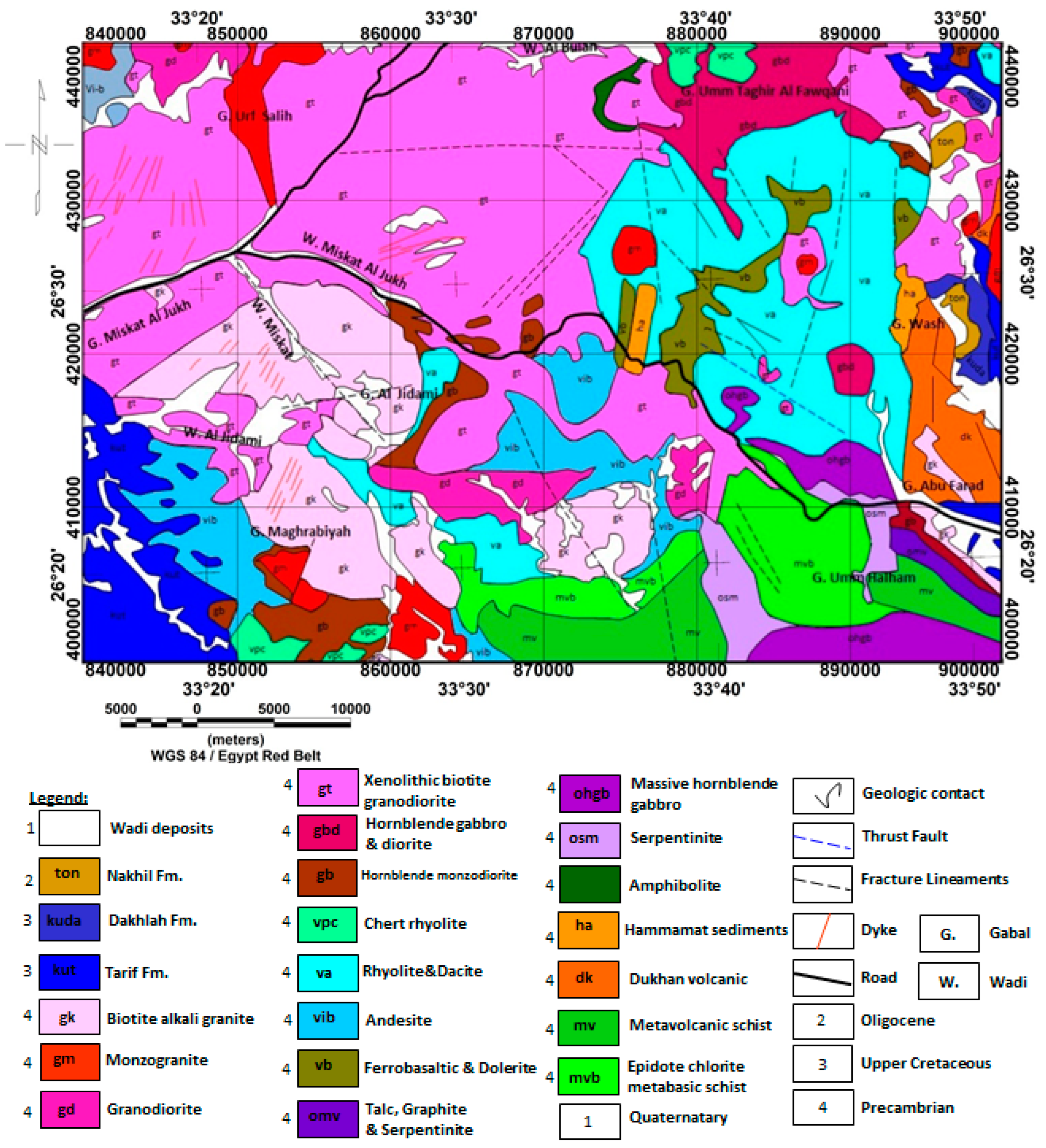



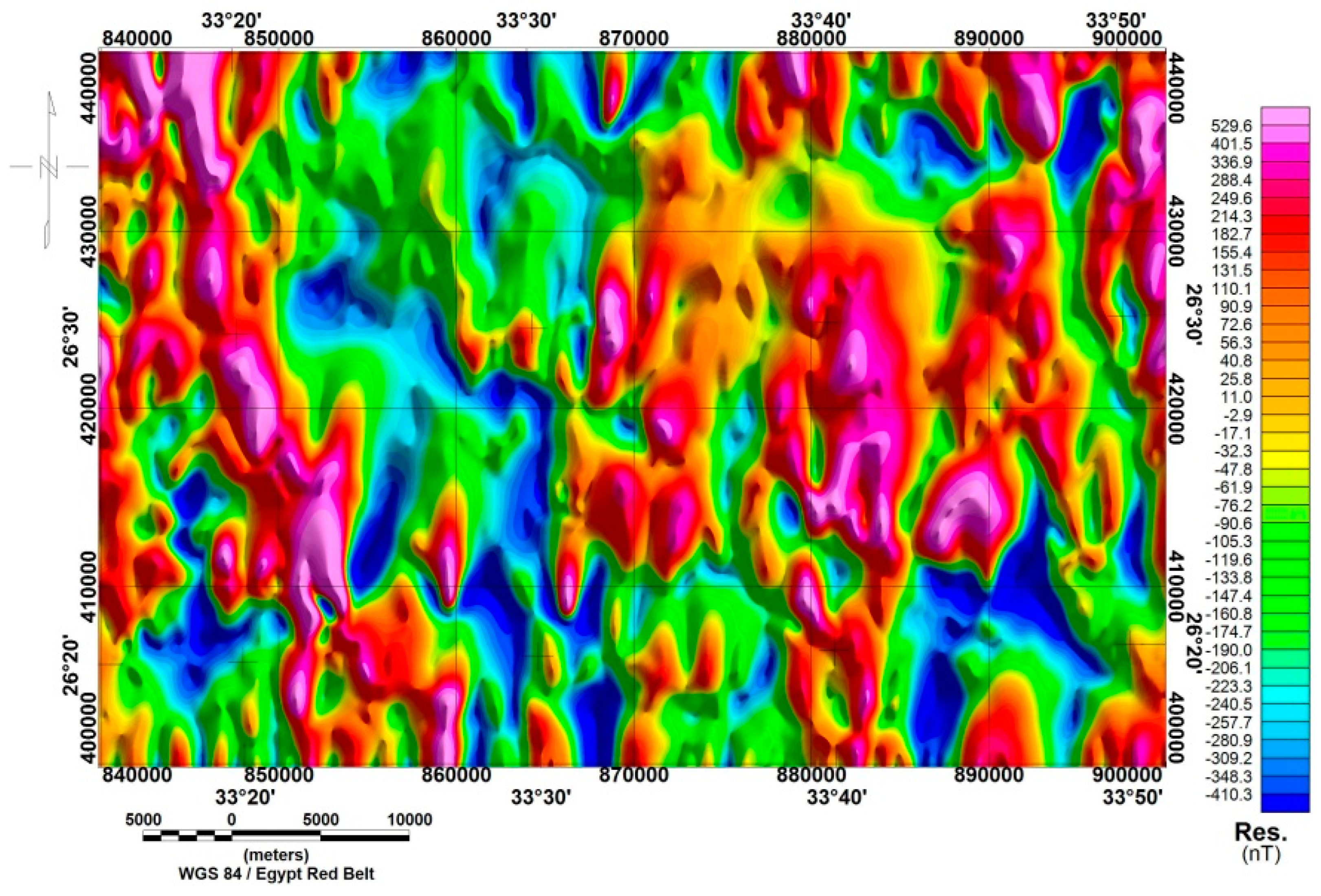
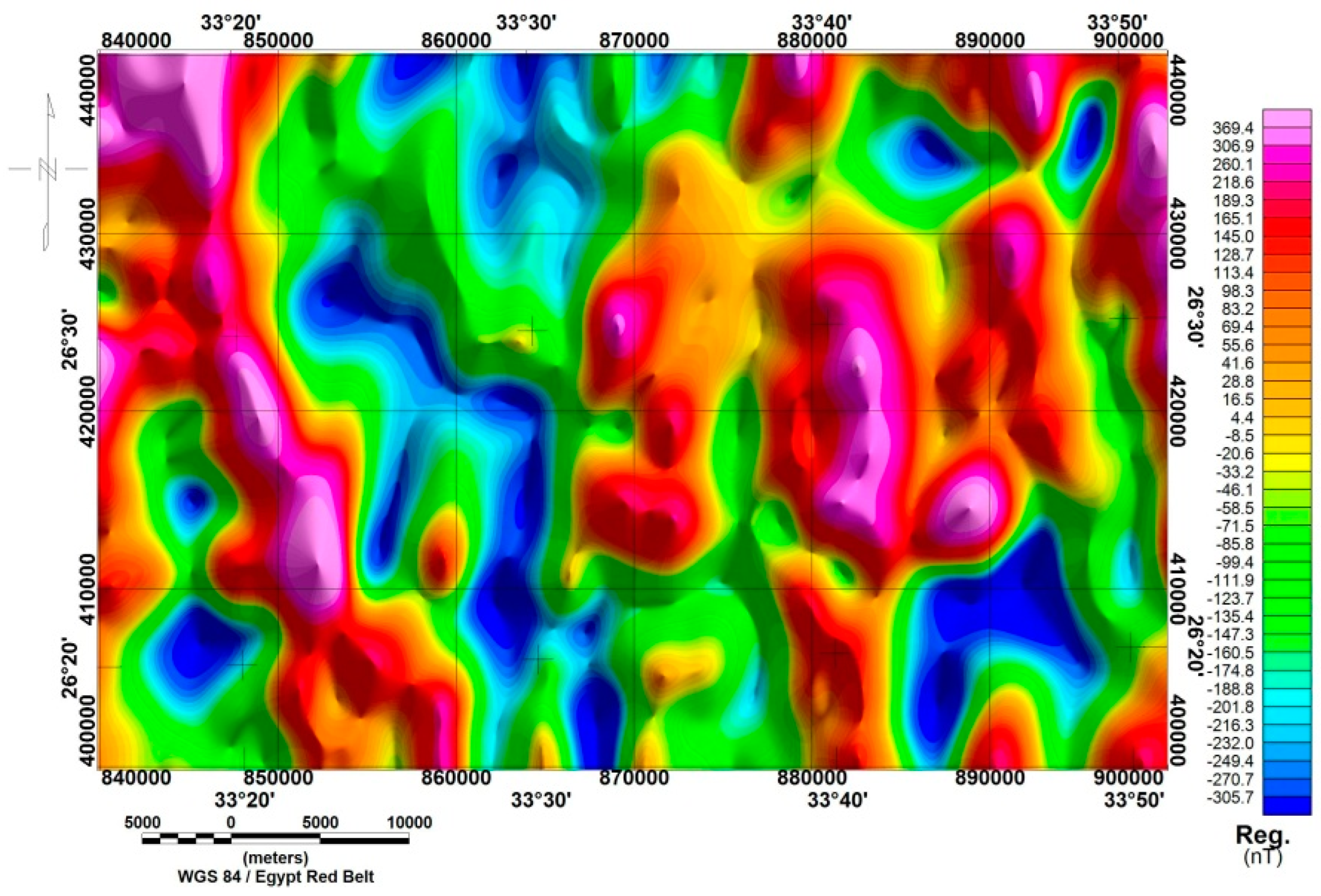
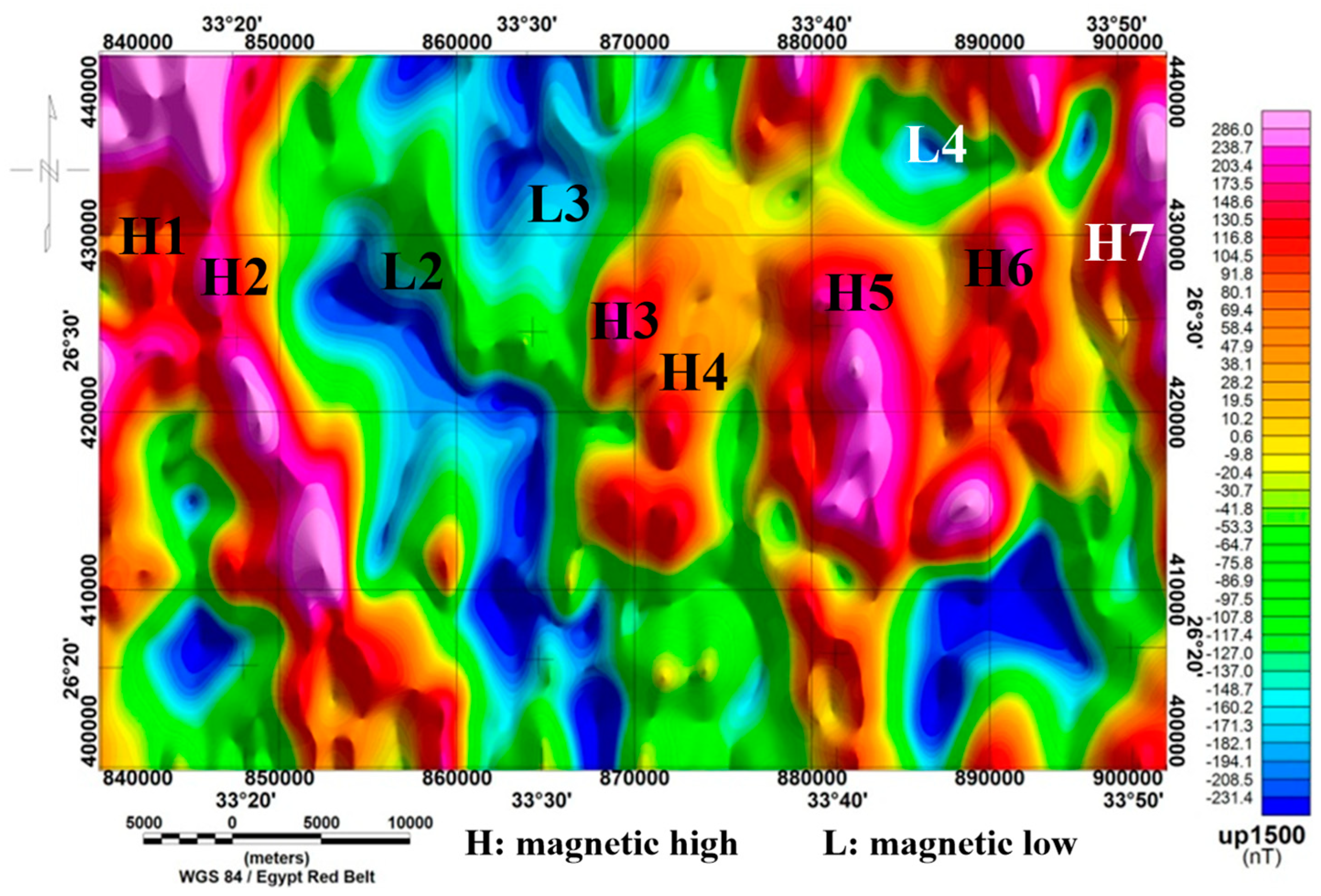

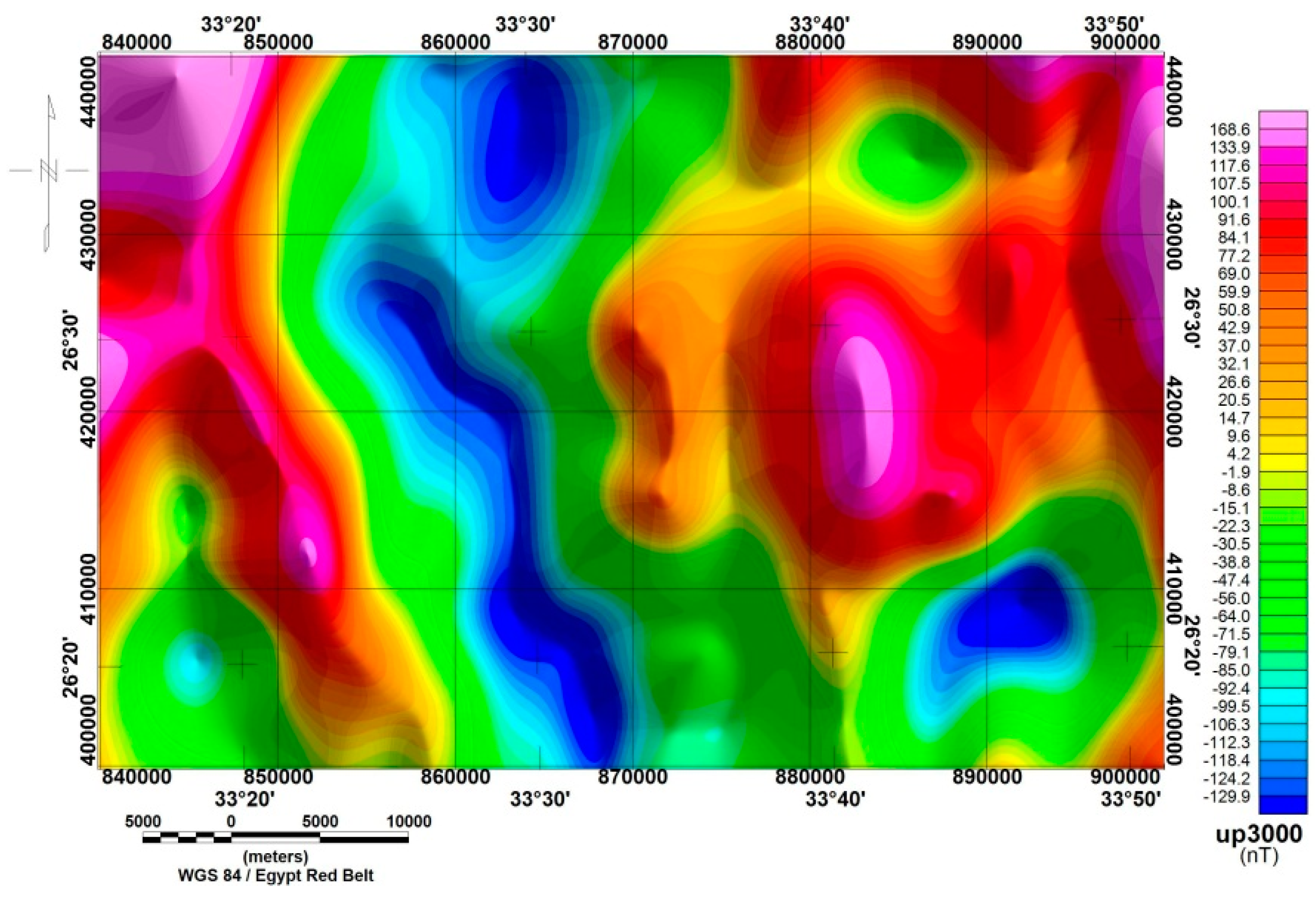
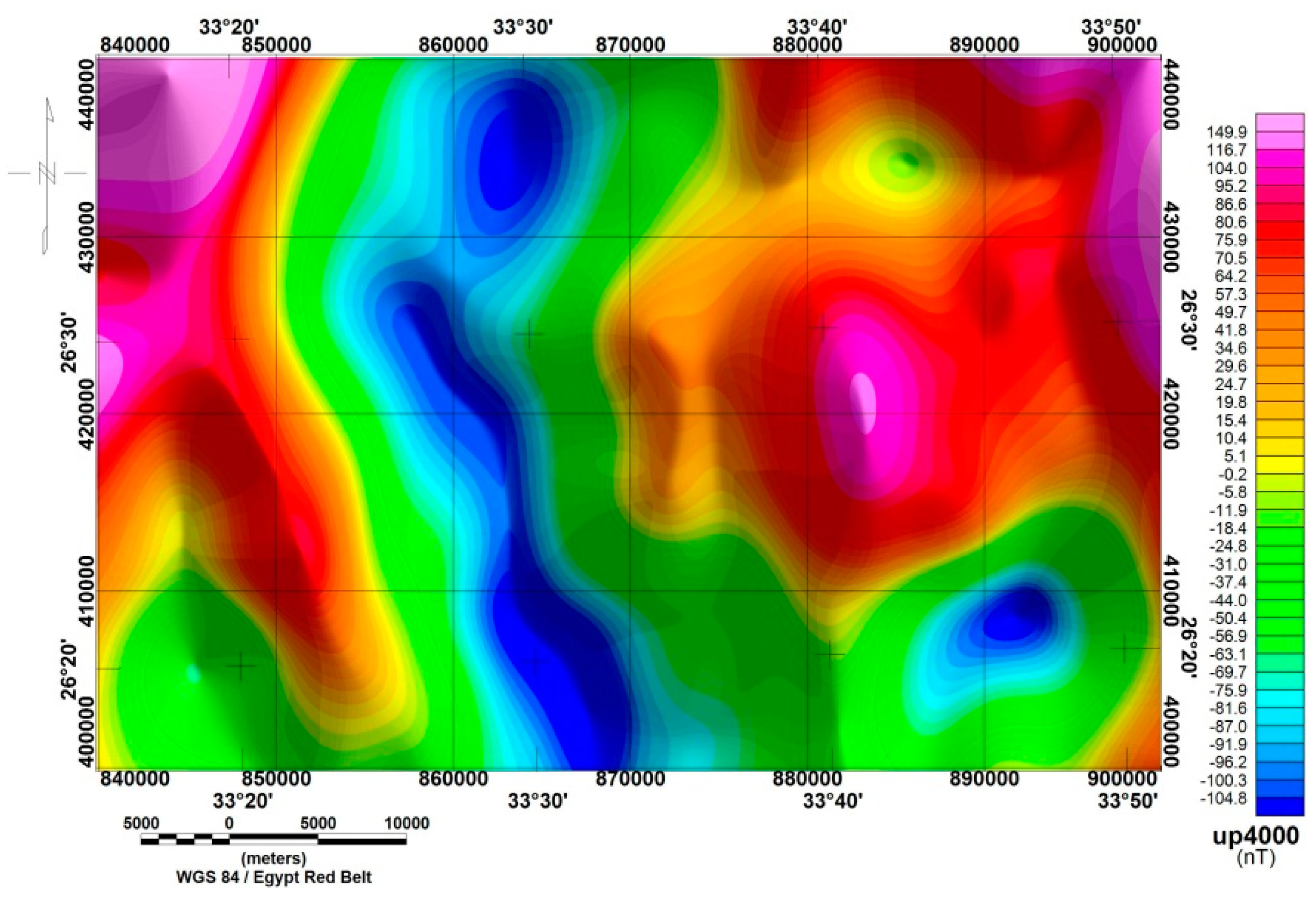
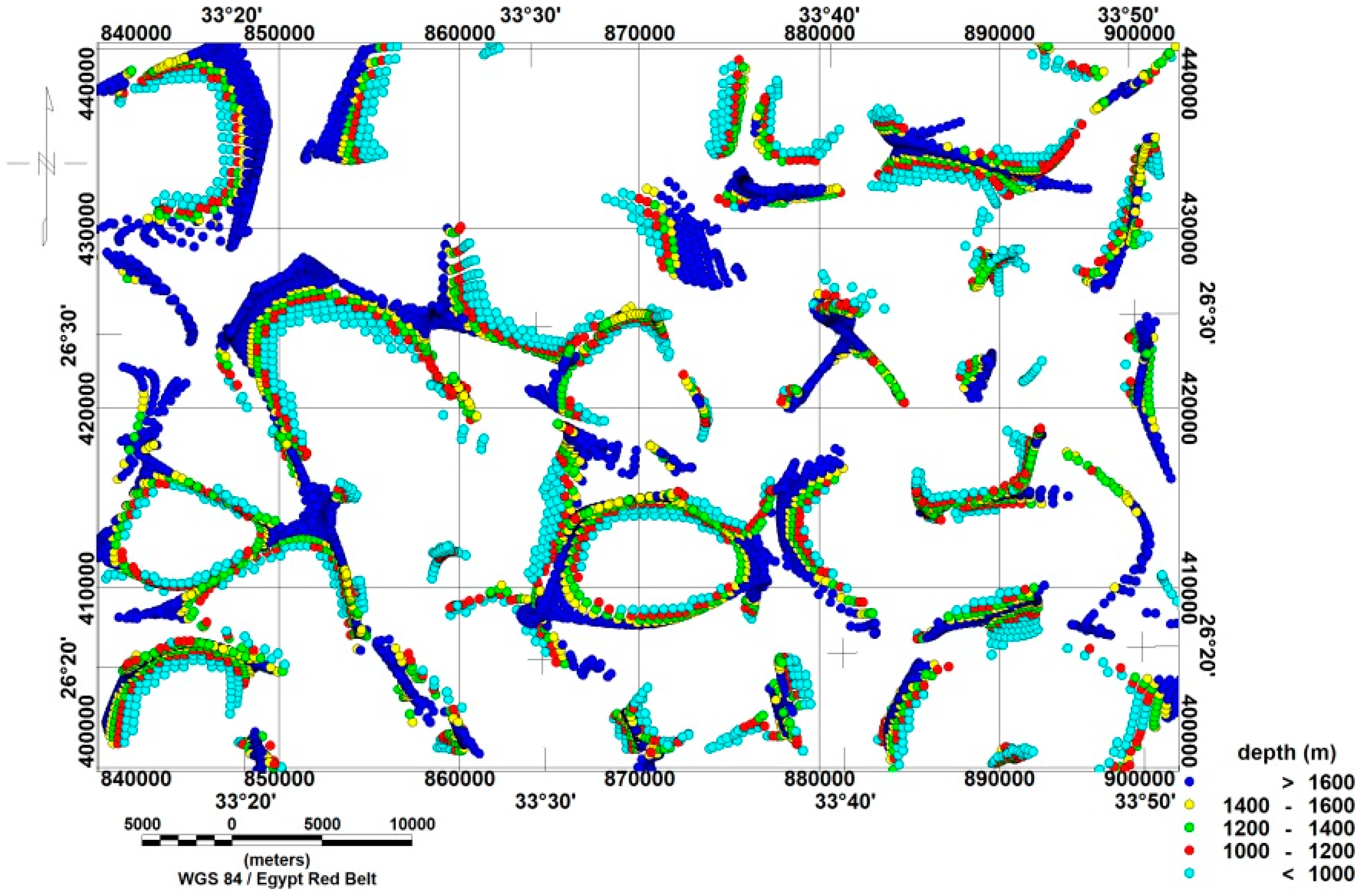
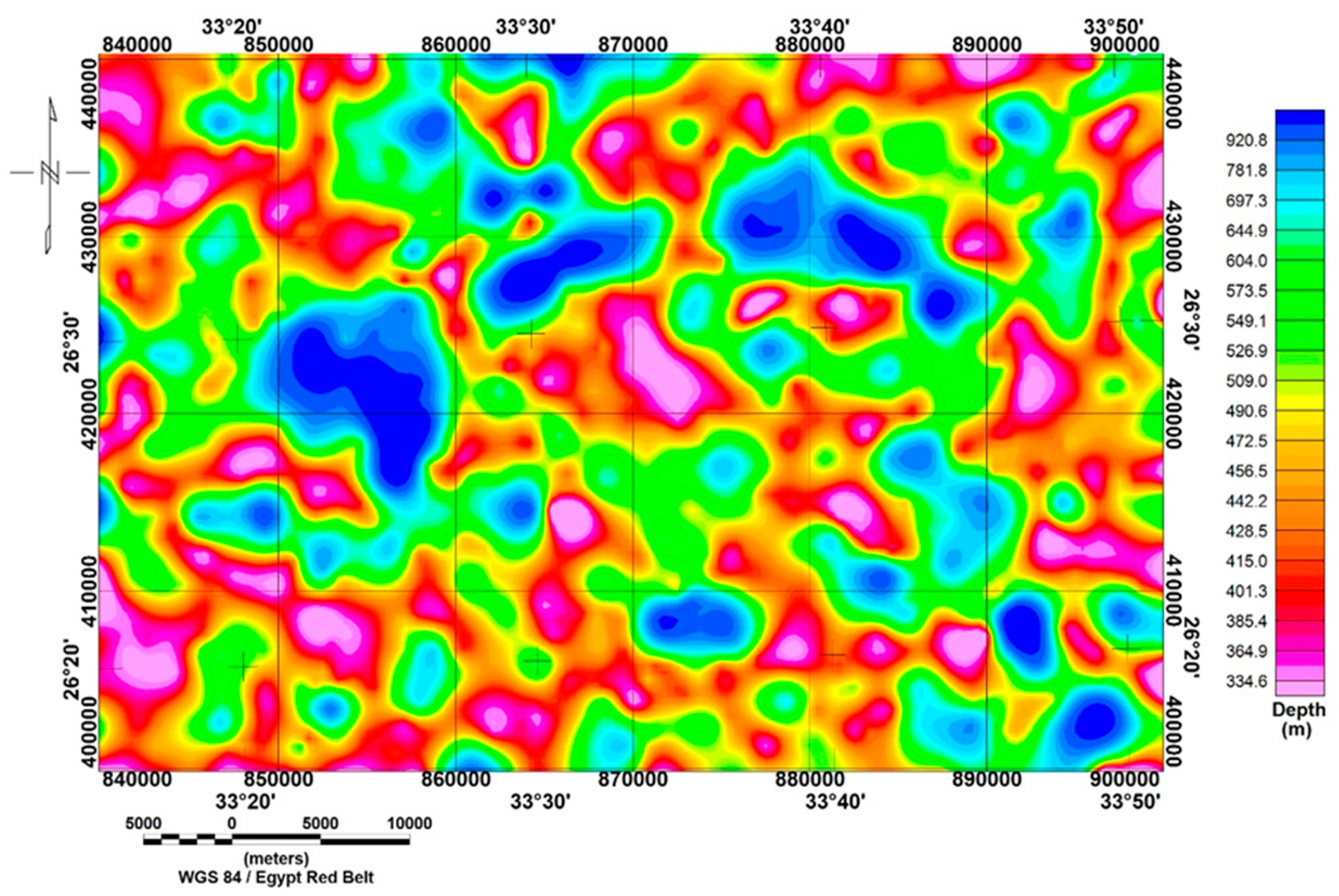
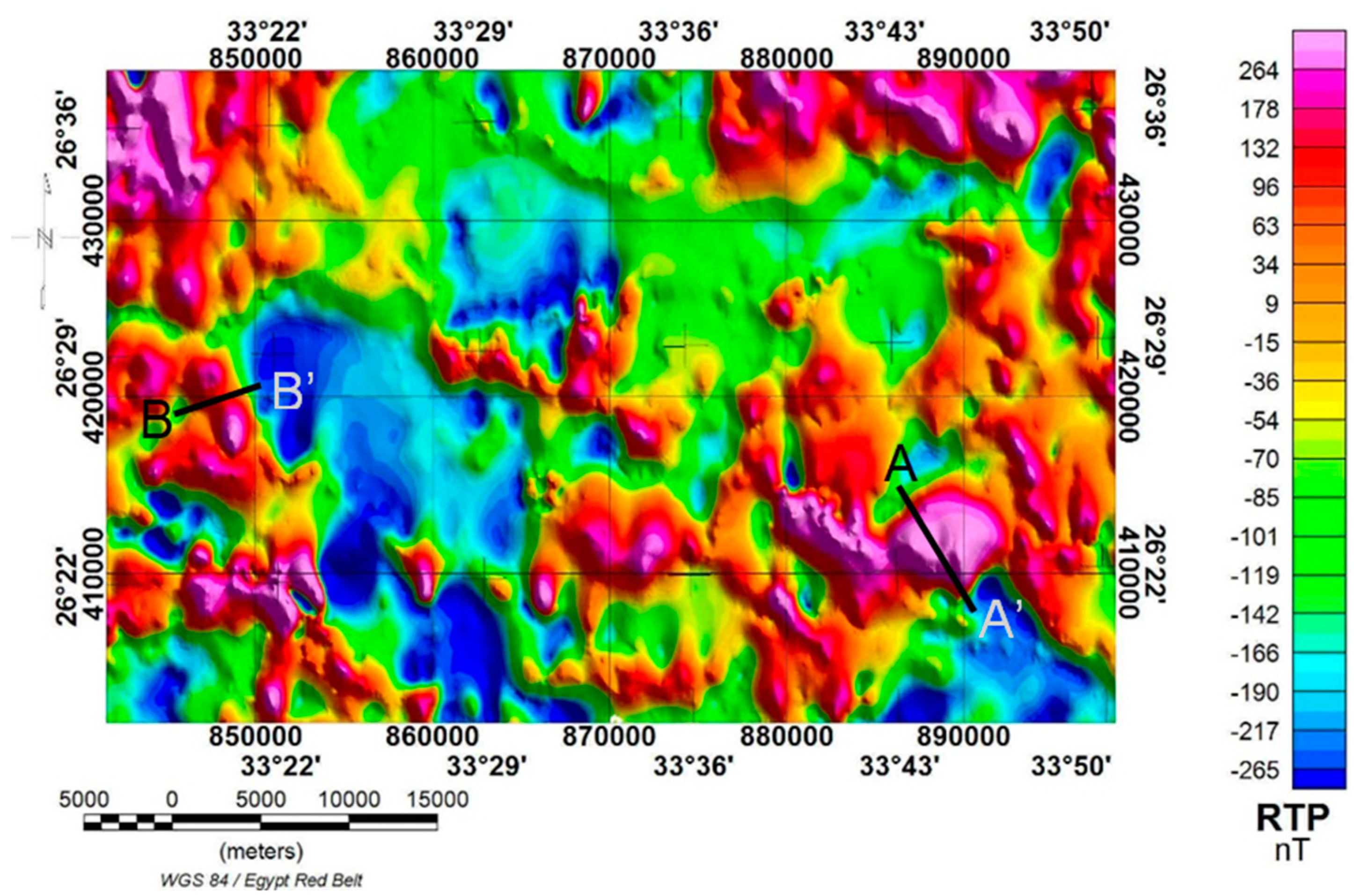

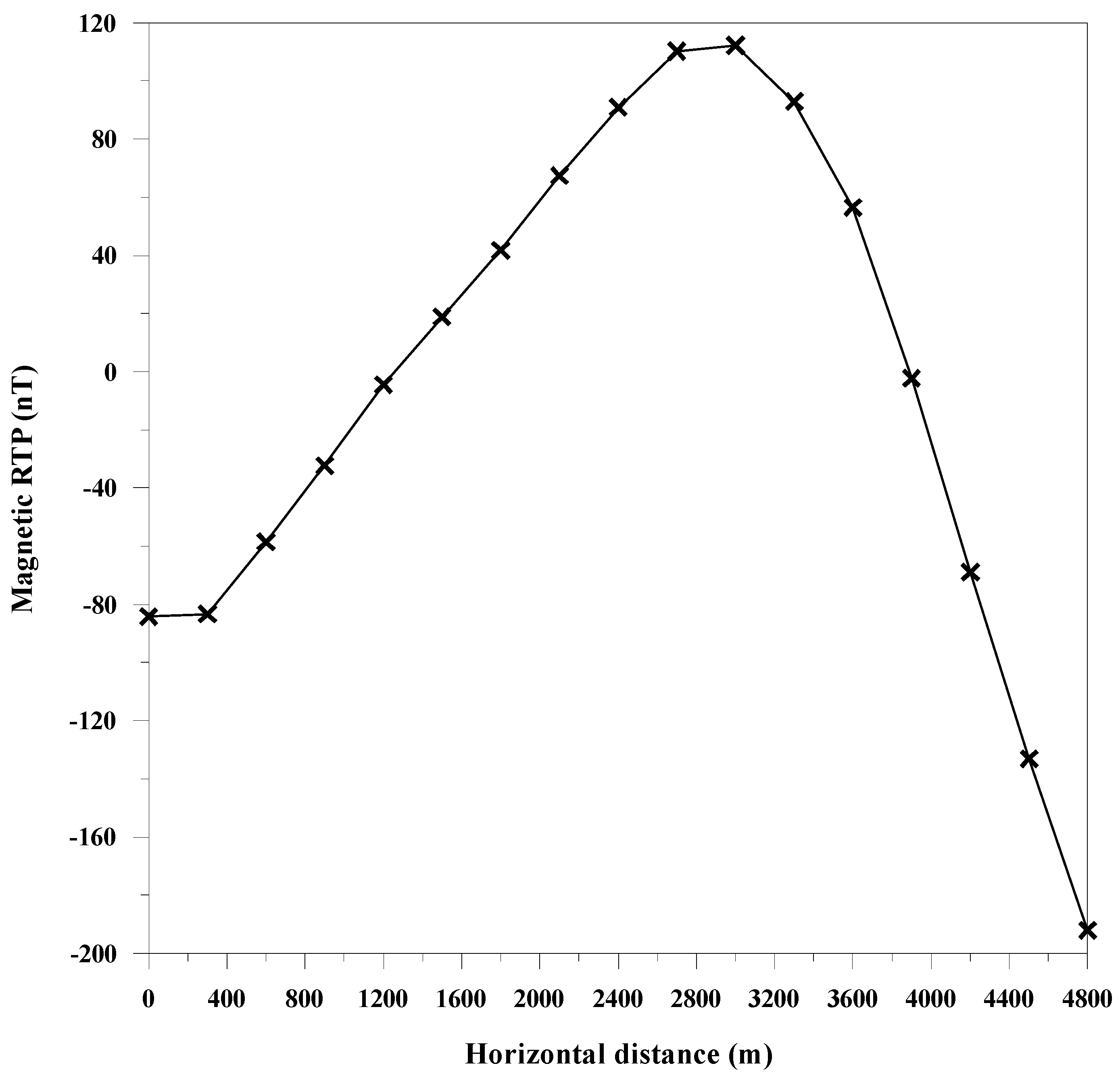
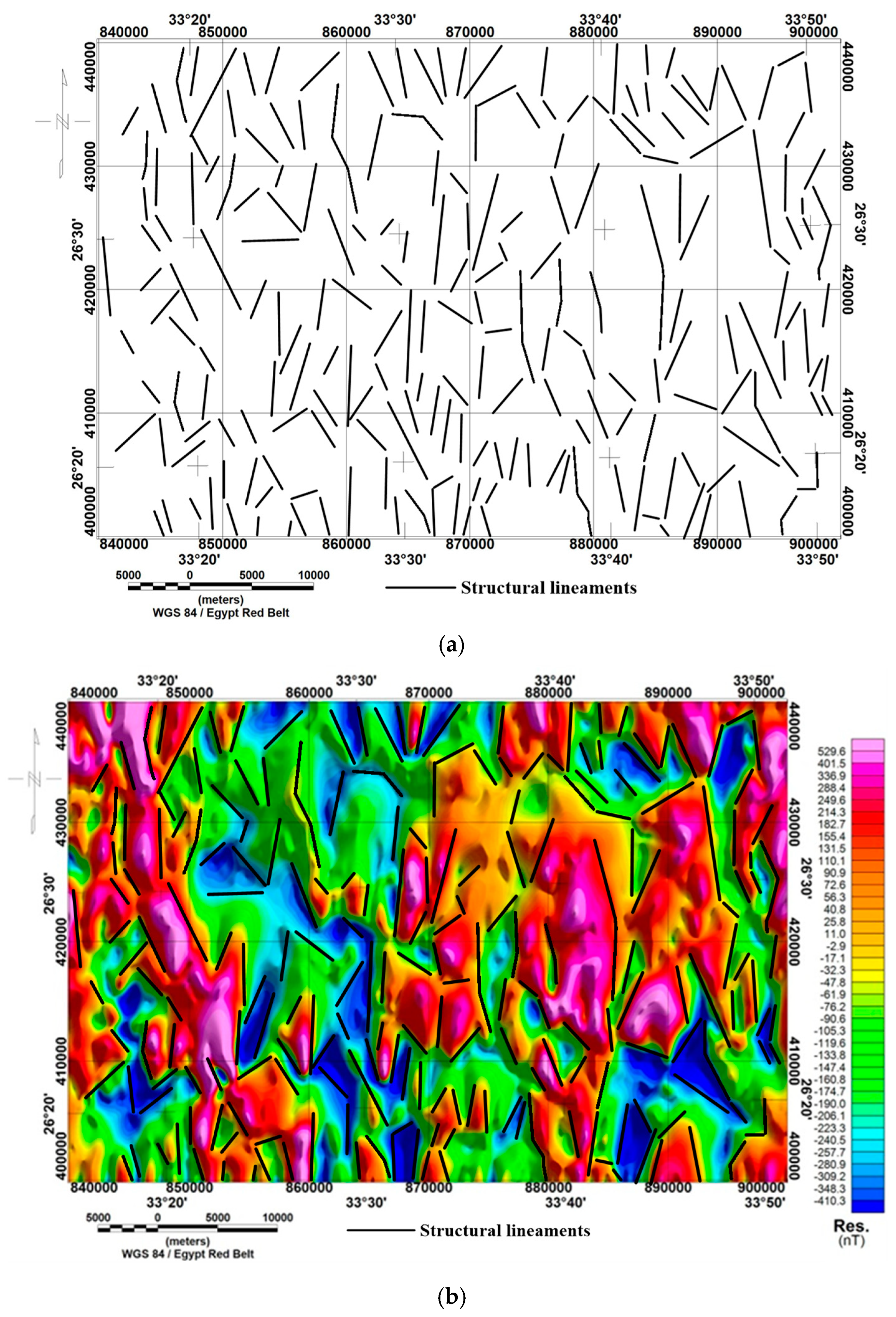


Disclaimer/Publisher’s Note: The statements, opinions and data contained in all publications are solely those of the individual author(s) and contributor(s) and not of MDPI and/or the editor(s). MDPI and/or the editor(s) disclaim responsibility for any injury to people or property resulting from any ideas, methods, instructions or products referred to in the content. |
© 2024 by the authors. Licensee MDPI, Basel, Switzerland. This article is an open access article distributed under the terms and conditions of the Creative Commons Attribution (CC BY) license (https://creativecommons.org/licenses/by/4.0/).
Share and Cite
Elhussein, M.; Barakat, M.K.; Alexakis, D.E.; Alarifi, N.; Mohamed, E.S.; Kucher, D.E.; Shokr, M.S.; Youssef, M.A.S. Aeromagnetic Data Analysis for Sustainable Structural Mapping of the Missiakat Al Jukh Area in the Central Eastern Desert: Enhancing Resource Exploration with Minimal Environmental Impact. Sustainability 2024, 16, 8764. https://doi.org/10.3390/su16208764
Elhussein M, Barakat MK, Alexakis DE, Alarifi N, Mohamed ES, Kucher DE, Shokr MS, Youssef MAS. Aeromagnetic Data Analysis for Sustainable Structural Mapping of the Missiakat Al Jukh Area in the Central Eastern Desert: Enhancing Resource Exploration with Minimal Environmental Impact. Sustainability. 2024; 16(20):8764. https://doi.org/10.3390/su16208764
Chicago/Turabian StyleElhussein, Mahmoud, Moataz Kh. Barakat, Dimitrios E. Alexakis, Nasir Alarifi, Elsayed Said Mohamed, Dmitry E. Kucher, Mohamed S. Shokr, and Mohamed A. S. Youssef. 2024. "Aeromagnetic Data Analysis for Sustainable Structural Mapping of the Missiakat Al Jukh Area in the Central Eastern Desert: Enhancing Resource Exploration with Minimal Environmental Impact" Sustainability 16, no. 20: 8764. https://doi.org/10.3390/su16208764











